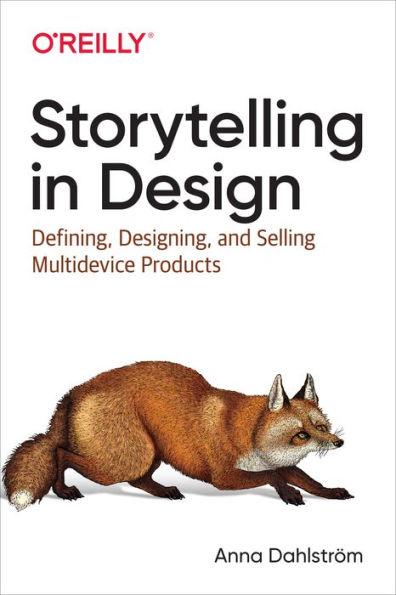Table of Contents
Preface ix
Chapter 1 Why Storytelling Matters 1
How This All Started 1
The Role of Stories Throughout History 4
The Medium of Stories 6
The Role of Personal Storytelling in Day-to-Day Lives 10
Storytelling Today 13
Stories as a Persuasion Tool 15
The Role of Storytelling in Product Design 17
Summary 20
Chapter 2 The Anatomy of a Great Story 21
The Architect Analogy of Explaining UX 21
Aristotle's Seven Golden Rules of Storytelling 23
The Three Parts to a Story 24
The Art of Dramaturgy 25
What Dramaturgy Teaches Us About Product Design 29
The Circular Nature of Digital Product Experiences 29
Five Key Storytelling Lessons 32
Chapter 3 Storytelling for Product Design 45
When Any Device, Used Anywhere and at Any Time, Is Your Starting Point 45
How Traditional Storytelling Is Changing 47
How the Landscape of Product Design Is Changing 64
Changes in Consumer Expectations 79
Summary 82
Chapter 4 The Emotional Aspect of Product Design 85
Shouting at the Voice Assistant 85
The Role of Emotion in Storytelling 87
The Role of Emotion in Product Design 88
Emotions and Our Different Levels of Needs 95
Understanding Emotions 100
Situations Where Emotion in Design Can Play a Key Role 107
What Storytelling Can Teach Us About Evoking Emotions in Product Design 115
Summary 124
Chapter 5 Defining and Structuring Experiences with Dramaturgy 125
Understanding and Defining Your Product Life Cycle 125
The Role of Dramaturgy in Storytelling 127
The Role of Dramaturgy in Product Design 128
Variations on the Three-Act Structure 131
Applying Sequencing and Mini-Stories to Product Design 136
The Difference Between Acts, Sequences, Scenes, and Shots 140
Understanding Plot Points 141
Plot Points in Product Design 146
Typical Experience Structures of Common Product Life Cycles 148
How to Use Dramaturgy and Plot Points to Define the Narrative Structure of Product Experiences 150
Summary 154
Chapter 6 Using Character Development in Product Design 157
Reluctance to Use Personas 157
The Role of Characters and Character Development in Storytelling 159
The Role of Characters and Character Development in Product Design 161
The Different Actors and Characters to Consider in Product Design 166
The Importance of Character Development 186
What Traditional Storytelling Teaches Us About Characters and Character Development 189
Character Definition Versus Character Development Versus Character Growth 199
Tools for Character Definition and Development in Product Design 200
Summary 207
Chapter 7 Defining the Setting and Context of Your Product 209
Once Doesn't Mean Always 209
The Role of Setting and Context in Storytelling 212
The Role of Setting and Context in Product Design 213
A Look at Context in Product Design 214
A Definition of Contextual Products and Context-Aware Computing 216
Working Through the Context 219
Embracing the Complexity of Context 221
The Factors and Elements That Make Up Context in Product Design 223
What Storytelling Teaches Us About Setting and Context 224
Summary 227
Chapter 8 Storyboarding for Product Design 229
One Document to Capture It All 229
The Role of Storyboarding for Film and TV 231
The Role of Storyboarding in Product Design 234
Using Storyboards to Help Identify the Invisible Problem and/or Solution 235
Creating Storyboards 238
Ways to Incorporate Storyboards into the Product Design Process 240
Summary 243
Chapter 9 Visualizing the Shape of Your Product Experience 245
"The Website Knows Me and What I Want" 245
The Shape of Stories 246
The Shapes of Experiences 259
Two Ways to Define the Shape of an Experience 259
When and How to Visualize an Experience 265
Summary 266
Chapter 10 Applying Main Plots and Subplots to User Journeys and Flows 267
The Ideal Journey 267
The Role of the Main Plot and Subplots in Traditional Storytelling 268
The Role of the Main Plot and Subplots in Product Design 269
Types of Subplots 271
What Storytelling Teaches Us About Working with Main Plots and Subplots 276
Summary 280
Chapter 11 Theme and Story Development in Product Design 281
Using Real Content 281
The Role of Theme and the Red Thread in Storytelling 283
The Role of Theme and the Red Thread in Product Design 286
Approaches to Developing Your Story in Traditional Storytelling 287
What Storytelling Teaches Us About Theme and Developing Your Product Story 290
Summary 293
Chapter 12 Choose-Your-Own-Adventure Stories and Modular Design 295
One Page for Every Athlete 295
CYOA Books and Modular Stories 296
CYOA and Product Design 298
The Case for Modularity in Product Design 299
The Need to Focus on the Building Blocks Rather Than the Page or View 302
Common Patterns in Choice-Based Stories 304
Key Principles from CYOA Structures Applied to Product Design 311
What Product Design Can Learn from CYOA 317
Summary 322
Chapter 13 Applying Scene Structure to Wireframes, Designs, and Prototypes 325
The Things That Didn't Fit Above the Fold 325
The Role of Scenes and Scene Structure in Product Design 328
Elements of a Scene 335
Elements That Help Tell the Story of a Page or View 338
What Scenes Teach Us About How to Define the Story of the Page or View 338
Summary 352
Chapter 14 Presenting and Sharing Your Story 353
How Storytelling Helped Save the Day 353
The Role of Storytelling for Presenting Your Story 355
What Traditional Storytelling Can Teach Us About Presenting Your Story 368
Summary 380
Index 381



